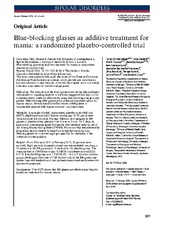| dc.contributor.author | Henriksen, Tone Elise Gjøtterud | en_US |
| dc.contributor.author | Skrede, Silje | en_US |
| dc.contributor.author | Fasmer, Ole Bernt | en_US |
| dc.contributor.author | Schøyen, Helle Kristine | en_US |
| dc.contributor.author | Leskauskaite, Ieva | en_US |
| dc.contributor.author | Bjørke-Bertheussen, Janette | en_US |
| dc.contributor.author | Assmus, Jörg | en_US |
| dc.contributor.author | Hamre, Børge | en_US |
| dc.contributor.author | Grønli, Janne | en_US |
| dc.contributor.author | Lund, Anders | en_US |
| dc.date.accessioned | 2017-01-04T10:47:48Z | |
| dc.date.available | 2017-01-04T10:47:48Z | |
| dc.date.issued | 2016-05 | |
| dc.Published | Bipolar Disorders 2016, 18(3):221-232 | eng |
| dc.identifier.issn | 1399-5618 | |
| dc.identifier.uri | https://hdl.handle.net/1956/15339 | |
| dc.description.abstract | Objectives: The discovery of the blue lightsensitive retinal photoreceptor responsible for signaling daytime to the brain suggested that light to the circadian system could be inhibited by using blue-blocking orange tinted glasses. Blue-blocking (BB) glasses are a potential treatment option for bipolar mania. We examined the effectiveness of BB glasses in hospitalized patients with bipolar disorder in a manic state. Methods: In a single-blinded, randomized, placebo-controlled trial (RCT), eligible patients (with bipolar mania; age 18–70 years) were recruited from five clinics in Norway. Patients were assigned to BB glasses or placebo (clear glasses) from 6 p.m. to 8 a.m. for 7 days, in addition to treatment as usual. Symptoms were assessed daily by use of the Young Mania Rating Scale (YMRS). Motor activity was assessed by actigraphy, and compared to data from a healthy control group. Wearing glasses for one evening/night qualified for inclusion in the intention-to-treat analysis. Results: From February 2012 to February 2015, 32 patients were enrolled. Eight patients dropped out and one was excluded, resulting in 12 patients in the BB group and 11 patients in the placebo group. The mean decline in YMRS score was 14.1 [95% confidence interval (CI): 9.7–18.5] in the BB group, and 1.7 (95% CI: −4.0 to 7.4) in the placebo group, yielding an effect size of 1.86 (Cohen's d). In the BB group, one patient reported headache and two patients experienced easily reversible depressive symptoms. Conclusions: This RCT shows that BB glasses are effective and feasible as add-on treatment for bipolar mania. | en_US |
| dc.language.iso | eng | eng |
| dc.publisher | Wiley | eng |
| dc.rights | Attribution CC BY-NC | eng |
| dc.rights.uri | http://creativecommons.org/licenses/by-nc/4.0/ | eng |
| dc.subject | activation | eng |
| dc.subject | bipolar disorder | eng |
| dc.subject | blueblockers | eng |
| dc.subject | chronotherapy | eng |
| dc.subject | dark therapy | eng |
| dc.subject | actigraph | eng |
| dc.subject | mania | eng |
| dc.subject | RCT | eng |
| dc.subject | virtual darkness | eng |
| dc.title | Blue-blocking glasses as additive treatment for mania: A randomized placebo-controlled trial | en_US |
| dc.type | Peer reviewed | |
| dc.type | Journal article | |
| dc.date.updated | 2016-12-15T09:46:13Z | |
| dc.description.version | publishedVersion | en_US |
| dc.rights.holder | Copyright 2016 The Author(s) | |
| dc.identifier.doi | https://doi.org/10.1111/bdi.12390 | |
| dc.identifier.cristin | 1364539 | |

